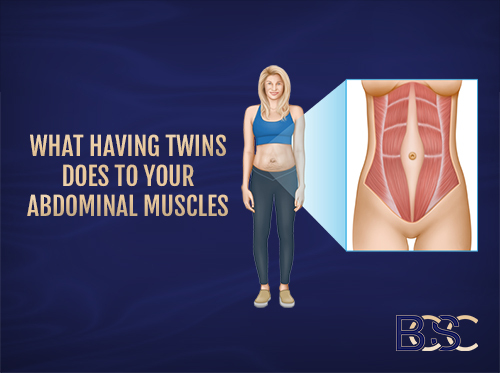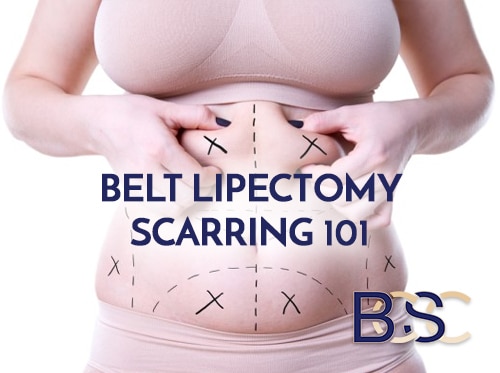Abdominoplasty Recovery & Downtime
Abdominoplasty recovery typically requires 2-3 weeks for initial healing. Full recovery can take up to 12 months as swelling subsides. Adequate rest, proper nutrition, and following your surgeon’s instructions can aid in swift recovery.
Despite the urge to return to your normal activities after an abdominoplasty, you should take time off to allow recovery. Several factors influence abdominoplasty recovery. These include age, overall health, weight, and the type of tummy tuck surgery (abdominoplasty).
Benefits of Abdominoplasty (Tummy Tuck) Procedure
Before learning about the tummy tuck recovery process, it’s essential to understand the benefits of an abdominoplasty. They include.
- Removing excess redundant fat and skin in the abdomen. Excess skin can be due to age, pregnancy, significant weight loss, or hormones.
- Enhancing abdominal contour
- Repairing separated abdominal muscles (diastasis recti)
- Achieving a firmer and flatter tummy
Abdominoplasty patients should be ** and have attained their ideal body weight. This will reduce the chances of significant weight changes after the procedure, interfering with the surgery and increasing the risk of revision abdominoplasty.
Patients should not undergo a tummy tuck procedure (abdominoplasty) as a weight loss replacement. Therefore, one should consider an abdominoplasty, where exercise or a healthy diet cannot fix the excess skin.
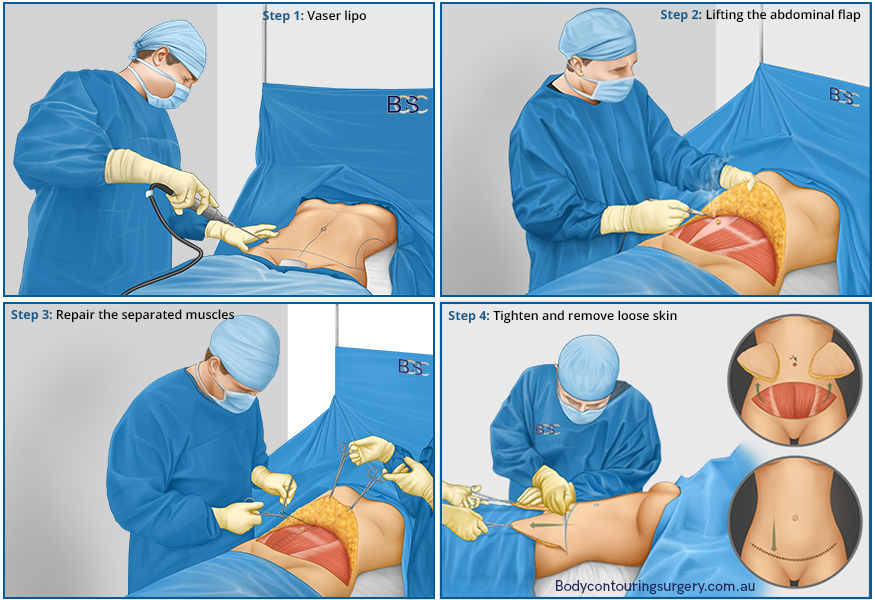
Summary of the Recovery Period for Abdominoplasty Procedures
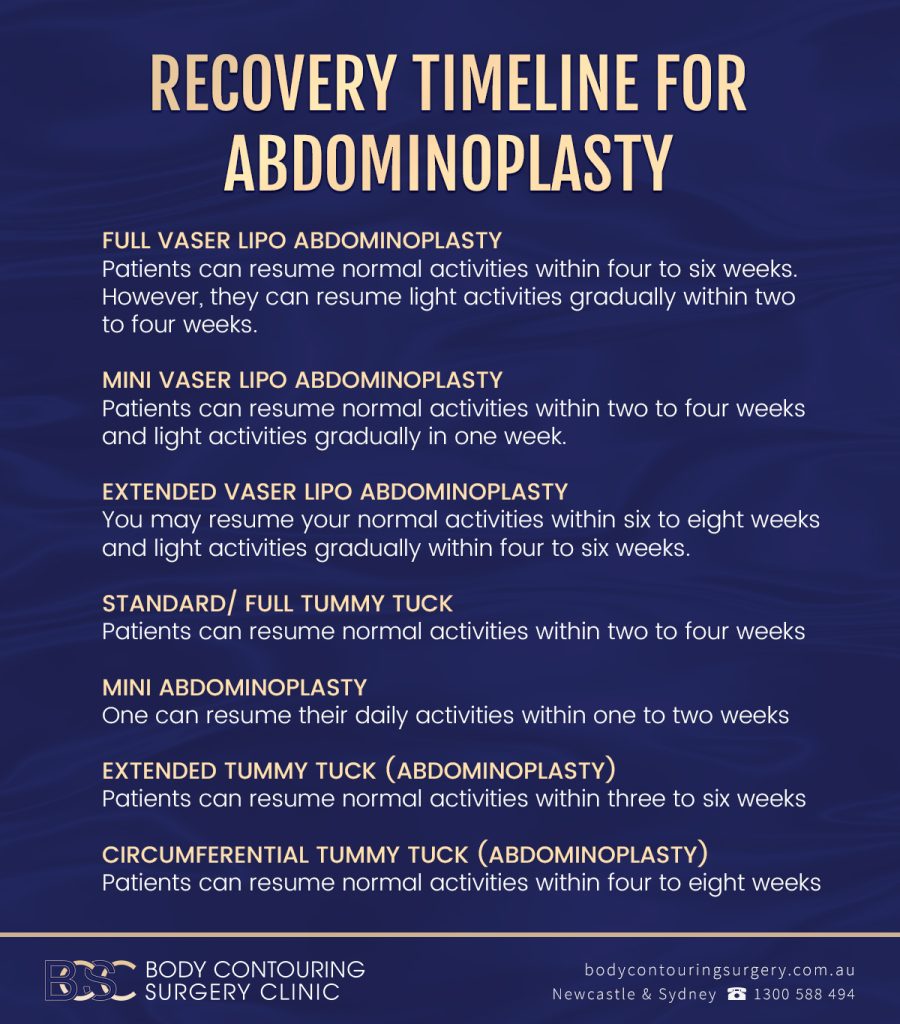
Different abdominoplasty procedures have different recovery periods. Incorporating additional procedures like liposuction will also affect the surgical and recovery periods. Below is the recovery period summary of some abdominoplasty procedures.
- Full Vaser Lipo Abdominoplasty: Patients can resume normal activities within four to six weeks. However, they can resume light activities gradually within two to four weeks.
- Mini Vaser Lipo Abdominoplasty: Patients can resume normal activities within two to four weeks and light activities gradually in one week.
- Extended Vaser Lipo Abdominoplasty: You may resume your normal activities within six to eight weeks and light activities gradually within four to six weeks.
- Standard/ Full Tummy Tuck: Patients can resume normal activities within two to four weeks
- Mini Tummy Tuck: One can resume their daily activities within one to two weeks
- Extended Tummy Tuck (Abdominoplasty): Patients can resume normal activities within three to six weeks
- Circumferential Tummy Tuck (Abdominoplasty): Patients can resume normal activities within four to eight weeks
Patients should avoid strenuous activities for extended periods until they have fully healed. Note that individual recovery periods may vary from the estimates. Therefore, always consult an experienced specialist surgeon for more personalised information on your abdominoplasty downtime.
Factors Affecting Abdominoplasty Recovery Period
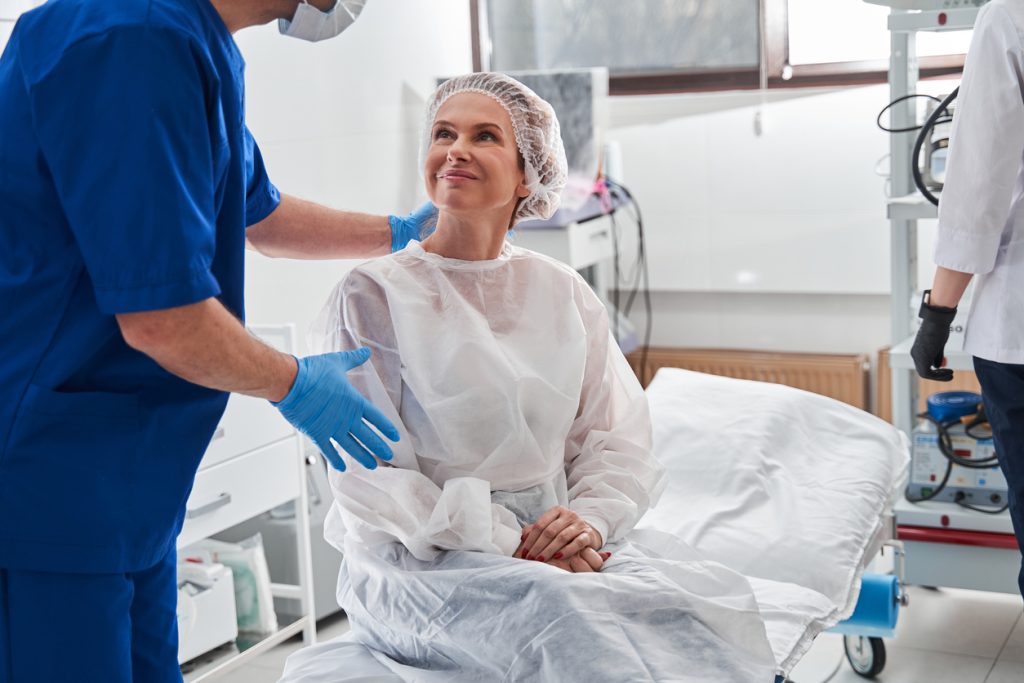
A tummy tuck recovery time varies due to several factors. These include the patient’s age, overall health, post-operative care, and the type of tummy tuck procedure.
The Age of the Patient’s
Younger abdominoplasty patients have a reduced recovery period than older patients. This is because one of the factors that ** healing is collagen, produced in large quantities in younger patients.
Patient’s Overall Health
Patients with good general health are more likely to heal faster than their counterparts with unstable health conditions.
Post-operative Care
After undergoing an abdominoplasty (tummy tuck surgery), the specialist surgeon will guide you on the dos and don’ts to promote recovery. Following these instructions to the letter will increase the recovery rate, reducing the expected recovery period.
Type of Tummy Tuck Procedure (Abdominoplasty)
Tummy tuck procedures vary in invasiveness, depending on how much excess skin the surgeon needs to remove. Patients undergoing extensive procedures experience longer recovery than those with less extensive procedures. We have:
Complete/ Full Tummy Tuck

Full abdominoplasty procedure removes excess redundant skin on the entire abdomen. In addition, it repairs separated abdominal muscles (diastasis recti). It is suitable for patients requiring excess skin and fat removal in the lower and upper abdomen or extensive repair of separated abdominal muscles.
This invasive procedure requires a horizontal hip-to-hip incision running along the bikini line. The surgeon will make an additional incision around the navel. A full abdominoplasty has a longer recovery period than a mini abdominoplasty.
Dr Bernard prefers full Vaser Lipo abdominoplasty. The procedure involves using ultrasonic liposuction to melt and suck excess abdominal fat. The patient then undergoes abdominoplasty after liposuction.
Mini Abdominoplasty

A mini abdominoplasty is less invasive compared to a full abdominoplasty. It removes excess skin and fat only on the lower abdomen and does not involve belly button reposition. The most suitable patients for this procedure should have minimal excess skin and fat, separated abdominal muscles on the lower abdomen, and a good upper abdomen.
The surgeon makes only a small incision, reducing the recovery time. Mini abdominoplasty also poses minimal scarring and post-operative risks that would affect healing. A mini Vaser Lipo abdominoplasty also has a reduced recovery time than a full Vaser Lipo abdominoplasty. This should take you around 3-4 weeks. It is however important to note that the recovery time will vary from one patient to another.
Extended Abdominoplasty

Extended abdominoplasty is more invasive than a full abdominoplasty procedure. Unlike the other procedures, extended tummy tuck ** excess skin on the tummy, back, and hip region. It is suitable for individuals with excess skin and fat not only on the tummy but also in the back and hip regions.
The procedure involves an extensive incision running horizontally along the waistline. Due to its extensiveness, extended tummy tuck has increased the recovery period.
Circumferential Abdominoplasty
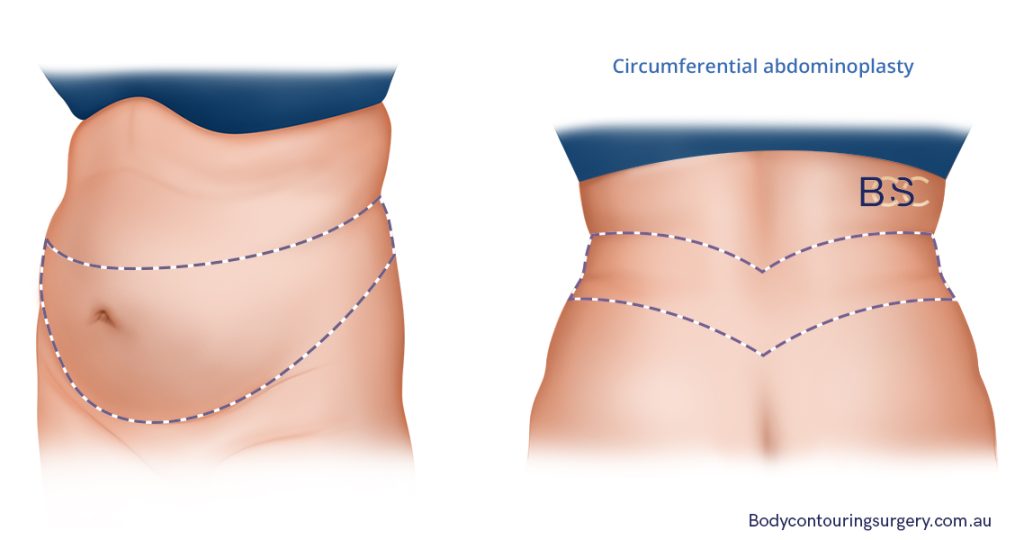
Circumferential abdominoplasty is also known as a body lift. The procedure is extensive, ** the abdomen, lower back, sides, and buttocks. Due to the extensive surgical area, the procedure takes the longest recovery period and has the highest reported post-operative discomfort.
Recovery Timeline for an Abdominoplasty Procedure
Most patient’s recovery takes 2-3 weeks, and they can resume their normal activities. However, individual factors may cause variation in the duration.
Recovery begins immediately after the procedure, and the patient goes into a recovery room or home care. Initially, the patient will experience soreness, swelling, fatigue, and pain. This is normal, and these will subside with time.
Let’s look at the tummy tuck recovery timeline.
Immediately After Surgery (Day One)
Surgeons perform abdominoplasties under a general anaesthesia. After the surgery, the patient is placed on hospital bed-rest for monitoring, and wearing off the anaesthesia effects. The duration of hospital stay depends on the procedure’s invasiveness.
The surgeon will cover the incision with PICO dressing and a compression garment. In some cases, there will be surgical drains to help drain excess wound fluid.
After a hospital stay, the patient will then go home. This may be the same day in less invasive procedures like mini abdominoplasty. Patients should have someone pick them up and drive them home. Before the anaesthesia wears off, you may feel groggy.
Week One
The first week is the most critical healing stage. You’ll experience soreness, bruising, and swelling during the first two to three days. You may also experience intense pain during this period after the anaesthesia wears off. However, pain medications will help relieve the pain.
The wound dressing will remain on, and you must ensure they are clean and changed as the surgeon advises. You must also wear the compression garment, only taking it off during a shower. You’ll experience discomfort and tightness around the tummy, especially when you stand or bend.
Get plenty of rest to ** healing and maximise the procedure’s results. However, you need to begin light activities like walking around the house. You can begin walking around the next day because the sooner you get out of bed and begin, the better.
Also, drink plenty of water and minimise sodium intake to reduce swelling. A bath is not recommended immediately after surgery. Ideally, it’s not recommended to bath for at least 4 weeks after the surgery. Note that the side effects you experience are expected and will subside with time. However, seek medical attention when you experience nausea, fever, redness around the wound, or unusual pain.
Week Two
The pain, tightness, and bruising begin subsiding in the second week. However, the incision site will still be swollen, and you must keep the compression garment on to reduce the swelling. Lymphatic massage at this stage will help reduce swelling.
Mostly, you can resume light activities or work, if it’s not physically demanding, by the end of week two. Ensure you take light walks but avoid exercising.
Week Three to Four
Bruising and pain have significantly subsided, sometimes completely gone, but the swelling is still significant. Note that 60% of swelling will subside in 3 months. However, you don’t have to wear compression garments throughout (day and night) and can begin your normal exercise routine. However, exercising should be gradual and after the surgeon’s approval. Make sure to avoid strenuous exercise at this time. Rest in between exercises, avoid exercising the abdominal area and strenuous activities.
The exercises to avoid include sit-ups, jarring steps, and weight lifting. You should avoid these core exercises for at-least 6-8 weeks if you previously had muscle repair. Maintain a healthy diet and stay hydrated. Also, continue applying scar treatments.
Week Four to Six
At this time, most patients can begin strenuous activities. However, you must first obtain the surgeon’s approval and gradually ease your way into the routine. Exercises include long walks, water, low-impact aerobics, and minimal weightlifting for legs and arms. Always watch for discomfort, pain, or other warning signs during exercise.
Continue applying scar treatments, maintaining a healthy diet, and staying hydrated.
Week Six to Eight
Most side effects are gone at this stage, and the tummy tuck results are now visible. You can do almost all the exercises. However, avoid applying too much pressure on the abdomen. Remember that it will take time for everything to get back to normal, and you must let your body adapt.
How Long Before the Final Results?

Disclaimer: Operation performed by Dr Bernard Beldholm. Adult content, surgery has risks; individual results vary, seek 2nd opinion. Please see the full disclaimer.
Abdominoplasty surgery final results are not immediate; however, you will notice significant changes after the surgery. The final results take time because of residual swelling and scars. Residual swelling can last 12-18 months to subside completely. However, expect scaring to fade for up to 2 years.
Note that scars take time to heal, and complete scar healing may take twelve months or more and around two years to fade. The complete healing period varies depending on the patient’s or the procedure’s complexity. Younger patients may heal faster than their older counterparts.
You must keep watch for abnormal scar healing. Abnormal scars may be hyperpigmented, thick, or extending past the incision site. Most abdominoplasty scars are along the bikini line, hence hidden by the underwear.
How Long Will You Stay in the Hospital After a Tummy Tuck Surgery?
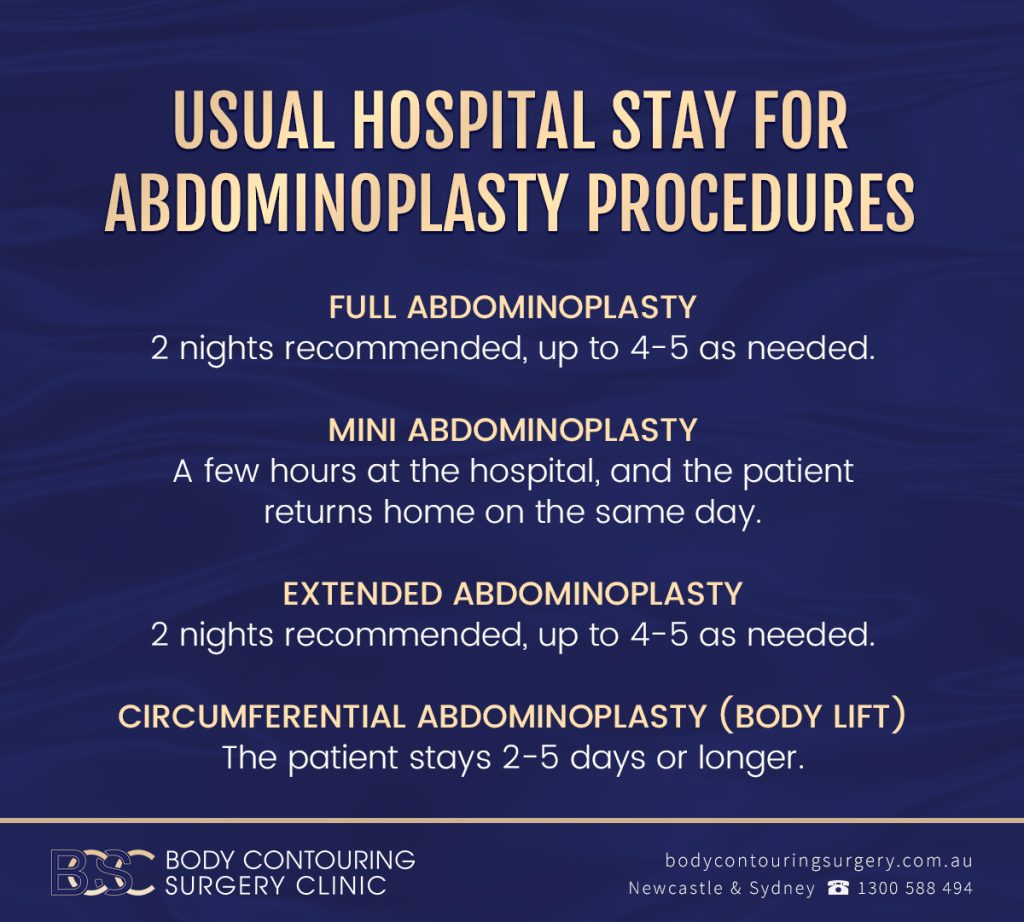
Usual hospital stay for abdominoplasty procedures | Infographic | BCSC
There are many variables that affect hospital stay. These include,
- Patient factors such as age, underlying health condition, and how fit they are
- Procedure’s complexity- more extensive procedures will require longer durations than less extensive procedures
- Patient’s reaction to anaesthesia
Mini abdominoplasty patients can usually go home on the same day, while those undergoing full and other extensive abdominoplasties need a few days in the hospital.
Going home the day after surgery for a full tummy patient is possible. However, there is often nausea and significant discomfort on the first day, making it difficult and painful to drive home. It is normal to be dizzy after anaesthetic as well as liposuction.
Dr Beldholm usually recommends staying at the hospital for at least 2 nights after any major abdominoplasty.
Below is a summary of the time required for a hospital stay for standard abdominoplasty procedures by Dr. Beldholm.
- Full Vaser Lipo Abdominoplasty – 2 nights recommended, up to 4-5 as needed.
- Mini Vaser Lipo Abdominoplasty – a few hours at the hospital, and the patient returns home on the same day
- Extended Vaser Lipo Abdominoplasty – 2 nights recommended, up to 4-5 as needed.
- Circumferential Abdominoplasty (Body Lift) – the patient stays 2-5 days or longer
Expected Post-Operative Care Following an Abdominoplasty Procedure
Before leaving the hospital, the surgeon will give guidelines to help during home recovery. These guidelines include post-operative care for incisions, surgical drains, compression garments, physical activity, diet, rest, follow-up appointments, and medication.
Compression Garments
After surgery, the surgeon will require you to wear a compression garment for around six weeks. Compression garments help reduce swelling by applying pressure, protecting and supporting the incision site. This ** recovery. You should wear a compression garment all day and night for at least two to three weeks.
Not wearing a compression garment may increase the risk of seroma, haematoma, increased bruising, swelling, and incision splitting.
Incision Care

The surgeon closes the incision using suture (stitches), or surgical glue/ tape. Immediately after surgery, the surgeon covers the incision with wound dressing. You must ensure incision hygiene by frequently cleaning the wound and changing the surgical dressing. However, at the Body Contouring Surgery Clinic, Dr Bernard uses PICO dressings and the wound doesn’t need to be cleaned. The nurse will clean and change the dressing on day 7 after surgery.
The incision will heal, leaving a permanent scar that fades with time. Mostly, the surgeon places the incision just above the pubic bone to reduce its visibility. Ensure to contact the surgeon if you notice any signs of infection.
Surgical Drains
Surgical drains help remove body fluids from the incision site, reducing swelling and promoting healing. The drains are temporary and will stay in place for about 2 to 7 days. In some instances, the surgeon will not use any surgical drains. Ensure you discuss with your surgeon how to care for the drains before the surgery or after leaving the hospital.
Pain Medication and Antibiotics
You’ll receive a prescription for antibiotics and painkillers before leaving the hospital. Antibiotics will help reduce the risk of infections, while the pain medication will help relieve the pain.
You will get IV antibiotics after your surgery. However, Dr. Beldholm does not recommend continuing to use antibiotics after this. “There is no research showing any benefit of this practice. However, the negative is that it can promote resistant bacteria and is also associated with thrush and gastro-intestinal symptoms,” he says.
Sleeping Position
Sleeping after an abdominoplasty can be challenging. The best position is to sleep inclined for a few days after surgery. Ensure you elevate the body with the knees slightly bent at an angle to reduce swelling. Placing pillows below the knees will increase ** and reduce abdominal pressure.
Ensure you get enough rest and sleep. Don’t confuse resting as sleeping or substitute it for rest. Enough sleep is important because when sleeping, the brain triggers the body to produce hormones that promote healing.
Physical Activity
Avoid strenuous activities after surgery. However, ensure you take light walks around the house. This ** blood flow, promoting recovery and reducing the risk of blood clots. You can ease back to normal exercises gradually as you heal.
Is an Abdominoplasty Procedure Painful?
Like any surgical procedure, the patient will experience pain after the effects of anaesthesia wear off. Most patients experience peak pain levels in the first two to three days. Painkillers can manage this.
However, the degree of pain is dependent on the individual. Whatever pain one person describes as extreme, another may describe it as minimal. Generally, every patient has different pain tolerance levels.
Recovery Tips After an Abdominoplasty
Ensuring healthy recovery is crucial after any surgical procedure. Below, find recovery tips that will help you ** recovery after an abdominoplasty.
- Following the surgeon’s post-operative instructions
- Taking a healthy diet rich in minerals and vitamins A and C
- Staying hydrated by drinking plenty of water
- Wearing support garments
- Avoiding alcohol, smoking, and other things that may affect healing
- Avoiding strenuous activities
- Minimal walking around the house
- Ensuring incision site hygiene by changing bandages and keeping the site dry and clean
- Getting enough rest and sleep
- Taking antibiotics and pain medication as prescribed
- Reporting any infections or complications to your surgeon
FAQS
Some frequently asked questions on abdominoplasty recovery and downtime include.
How long should I take off work?
This will depend on your work’s physical demand. However, most patients take between two to three weeks off. After two to three weeks, you can resume light daily activities.
Is abdominal tightness normal after the procedure?
After the surgery, you will feel tightness around the abdomen when you try to stand, lie flat, or move. This results from the incision stitches and any abdominal muscle repair.
The tightness will feel ** and limit mobility. However, it’s normal and subsides with time, within six to twelve weeks.
When will the swelling after an abdominoplasty subside?
In most cases, most swelling will subside within six to eight weeks. However, residual swelling can take up to twelve months.
Is walking recommended after an abdominoplasty?
Walking after an abdominoplasty is recommended since it ** blood circulation, promoting healing. However, take only light walks, especially around your home, and avoid long, straining walks.
When can I drive after an abdominoplasty?
If you’re considering a tummy tuck surgery (abdominoplasty), one of your primary concerns is when you can resume driving. You should take some time before you resume driving. Most patients can resume driving after two to three weeks.
To determine if you are ready to resume driving, check if you can sit ** on the car seat, open the car door **, turn the wheel without challenges, and make emergency stops or sharp turns.
After how long can I go swimming after an abdominoplasty?
Swimming can affect the healing process due to infections from bacteria and germs in the swimming pool. Also, swimming can stretch the incision, splitting it. Therefore, you should ensure the incision wound has healed enough to allow swimming, usually after 4 to 6 weeks. In addition, ensure to protect the scar adequately when swimming.
Can I have sexual intercourse after an abdominoplasty?
You should avoid any sexual activity until you recover from a tummy tuck. Sexual activity will exert pressure on the abdominal area, affecting the incision and healing. If the surgery is less invasive, you can resume sexual activity after two weeks. However, if the surgery is extensive, you must wait for at least four weeks.
Bottom Line
The recovery after abdominoplasty surgery is crucial since it affects results. After the surgery, you must take some time off your job and normal daily activities. Many patients can resume their daily activities after two to three weeks; however, individual downtime after an abdominoplasty varies.
Following the post-surgical procedures can help ** tummy tuck recovery and reduce downtime. Also, it is important to get out of bed and start walking lightly in the house as soon as possible because it ** recovery. Always consult your surgeon before resuming any activity or after noting any abnormality during wound healing.
References
- Shauly, O., Goel, P., & Gould, D. J. (2022). Painless, Drainless lipoabdominoplasty: A retrospective study of pain following lipoabdominoplasty utilizing liposomal bupivacaine and a modified enhanced recovery after surgery protocol. Aesthetic Surgery Journal, 4.
- Choi, H. Y., & Kim, K. T. (2000). A new method for aesthetic reduction of labia minora (the deepithelialized reduction labioplasty). Plastic and Reconstructive Surgery, 105(1), 419–422.
- Brauman, D., Van Der Hulst, R. R. W. J., & Van Der Lei, B. (2018). Liposuction assisted abdominoplasty. Plastic and Reconstructive Surgery. Global Open, 6(9), e1940. Borille, G., Filho, G. P., Zancanaro, M., Giannini, R., Reynosso, L., Avalos, V., & Nahas, F. X. (2022). Medium definition liposuction abdominoplasty. Plastic and Reconstructive Surgery. Global Open, 10(5), e4053.
- Borille, G., Filho, G. P., Zancanaro, M., Giannini, R., Reynosso, L., Avalos, V., & Nahas, F. X. (2022b). Medium definition liposuction abdominoplasty. Plastic and Reconstructive Surgery. Global Open, 10(5), e4053.
- Wu, S. S., Coombs, D. M., & Gurunian, R. (2020). Liposuction: Concepts, safety, and techniques in body-contouring surgery. Cleveland Clinic Journal of Medicine, 87(6), 367–375.
- De Souza Pinto, E. B., De Souza Pinto Abdala, P. C., Maciel, C. M., De Paula Turchiari Dos Santos, F., & De Souza, R. P. M. (2006). Liposuction and VASER. Clinics in Plastic Surgery, 33(1), 107–115.
- O’Kelly, N., Nguyen, K. T., Gibstein, A., Bradley, J. P., Tanna, N., & Matarasso, A. (2020). Standards and Trends in Lipoabdominoplasty. Plastic and Reconstructive Surgery. Global Open, 8(10), e3144.
- Kosloski, F. R., Barbosa, M. V. J., Rodrigues, M. A., Martins, M. R. C., Ferreira, L. M., & Nahas, F. X. (2023). Effect of compression garments on the ventilatory function after abdominoplasty. Aesthetic Surgery Journal.
- Bhargava, D. (2008). Abdominoplasty today. Indian Journal of Plastic Surgery: Official Publication of the Association of Plastic Surgeons of India, 41(Suppl), S20.
- Smith, M. M., Lin, M. P., Hovsepian, R. V., Wood, D., Nguyen, T., Evans, G. R., & Wirth, G. A. (2008). Postoperative seroma formation after abdominoplasty with placement of continuous infusion local anesthetic pain pump. The Canadian Journal of Plastic Surgery, 17(4), 127-129.
- Grieco, M., Grignaffini, E., Simonacci, F., & Raposio, E. (2015). Analysis of Complications in Postbariatric Abdominoplasty: Our Experience. Plastic Surgery International, 2015.
- Harris, L., & Darby, P. (2020). Enhanced Recovery after Abdominoplasty Using Perisurgical Nutritional Supplementation. Plastic and Reconstructive Surgery Global Open, 8(12).
- Vidal, P., Berner, J. E., & Will, P. A. (2017). Managing Complications in Abdominoplasty: A Literature Review. Archives of Plastic Surgery, 44(5), 457-468.
- Winocour, J., Gupta, V., Ramirez, J., Shack, R. B., Grotting, J. C., & Higdon, K. (2015d). Abdominoplasty. Plastic and Reconstructive Surgery, 136(5), 597e–606e.
